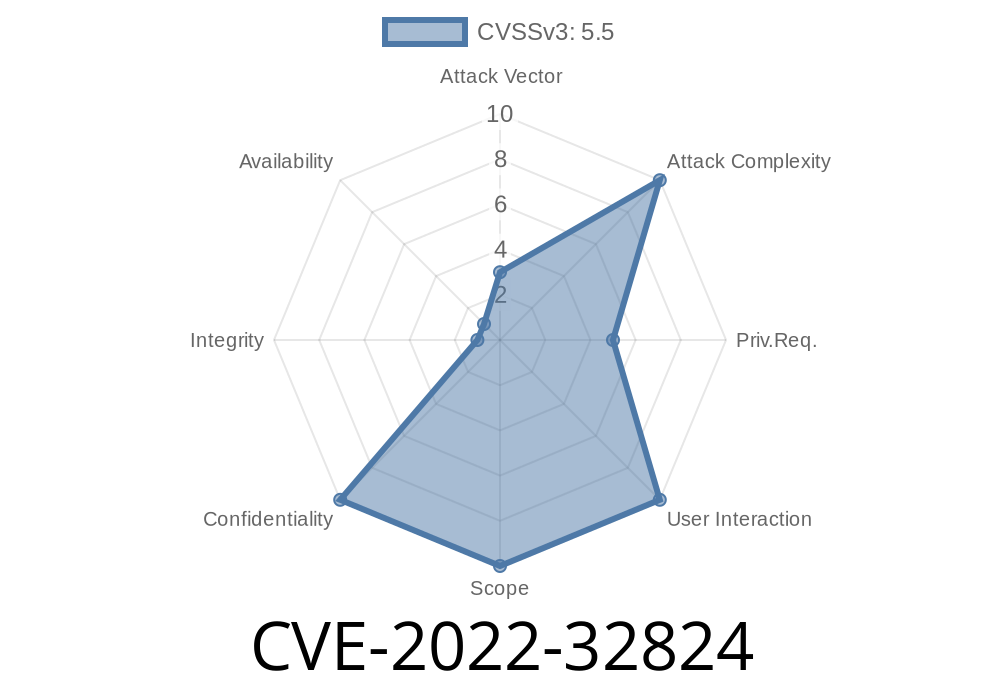Apple devices are known for their robust security, but even the best systems can have bugs. One such major issue was CVE-2022-32824—a kernel vulnerability that would let a malicious app snoop into sensitive areas of device memory it should never access.
Let’s break down what happened, how it worked, and why updating to the latest versions of Apple’s OS is so important.
What is CVE-2022-32824?
CVE-2022-32824 is the ID assigned to a specific security flaw found in Apple’s kernel—the core part of the operating system that manages hardware and system resources.
Affected Devices
- iPhones and iPads (before iOS 15.6 / iPadOS 15.6)
Apple TV (before tvOS 15.6)
Risk:
A malicious app could exploit this flaw to read parts of kernel memory. The kernel often holds very sensitive data (like passwords or encryption keys); leaking any of this can be devastating.
Apple’s Advisory:
> "An app may be able to disclose kernel memory. This issue was addressed with improved memory handling."
> — Apple Security Updates (iOS 15.6)
What Actually Went Wrong? (Technical Details)
Because Apple keeps kernel bug details close to the chest, public proofs-of-concept for this bug are rare. But thanks to researchers digging into iOS security, here’s a simplified explanation:
1. Kernel Memory Exposure: When user apps make certain requests to the kernel (through “system calls” or similar interfaces), the kernel would sometimes return data blocks that weren’t fully wiped or cleaned beforehand.
2. Uninitialized Data: The un-filled areas could contain leftovers from previous kernel memory operations—including private data, credentials, or even fragments of other apps’ processes.
3. No Special Privileges Needed: A regular app could ask for these responses, no root or jailbreak needed.
Here’s a simplified pseudo-code illustrating how a bug like this might work
// Pseudo-code: Kernel function handling a user request
int kernel_request_handler(user_buffer, size) {
struct kernel_struct result; // Allocated but not fully cleared
// ... set up part of result ...
copy_to_user(user_buffer, &result, size); // Copies whole struct, including uninitialized bytes!
return ;
}
If result isn’t zeroed out (memset(&result, , sizeof(result));), unused fields might leak data.
*This is a hypothetic simplification. The real bug’s details are more complex, but follow the same unsafe memory handling logic.*
Publish an innocent-looking app on the App Store.
- Inside the app, repeatedly call the vulnerable kernel function, scraping leaked memory on every call.
Sift through the scraps, looking for sensitive material (credentials, secrets, etc.).
Note:
With kernel memory leaks, all bets are off—attackers could chain this with other bugs for deeper device compromise.
tvOS 15.6
The Fix:
“Improved memory handling.” This almost always means either
- Making sure all kernel structs and buffers are fully initialized/zeroed before being returned to userspace.
A secure version of the earlier snippet would look like
int kernel_request_handler(user_buffer, size) {
struct kernel_struct result = {}; // Zero every field!
// ... set up result ...
copy_to_user(user_buffer, &result, size);
return ;
}
Takeaways: Why Does This Matter?
- Kernel leaks are very dangerous. They can expose sensitive data, help attackers bypass other protections, or even enable jailbreak/root exploits.
Even apps with no special permissions can exploit such bugs if unpatched.
- Always update your device. These sorts of security bugs get fixed in major (and minor) OS updates. Lagging behind is asking for trouble.
Want to Learn More?
- Apple’s security advisory for iOS 15.6: HT213345
- Master CVE record: https://cve.mitre.org/cgi-bin/cvename.cgi?name=CVE-2022-32824
In summary:
CVE-2022-32824 was a kernel-level bug that could let any app spy on secrets deep inside your Apple device, all because of sloppy memory cleanup. Apple’s fix was simple—always wipe your memory before you share it. This bug is a classic reminder: security is only as strong as your weakest memory operation.
Timeline
Published on: 02/27/2023 20:15:00 UTC
Last modified on: 03/08/2023 14:36:00 UTC
